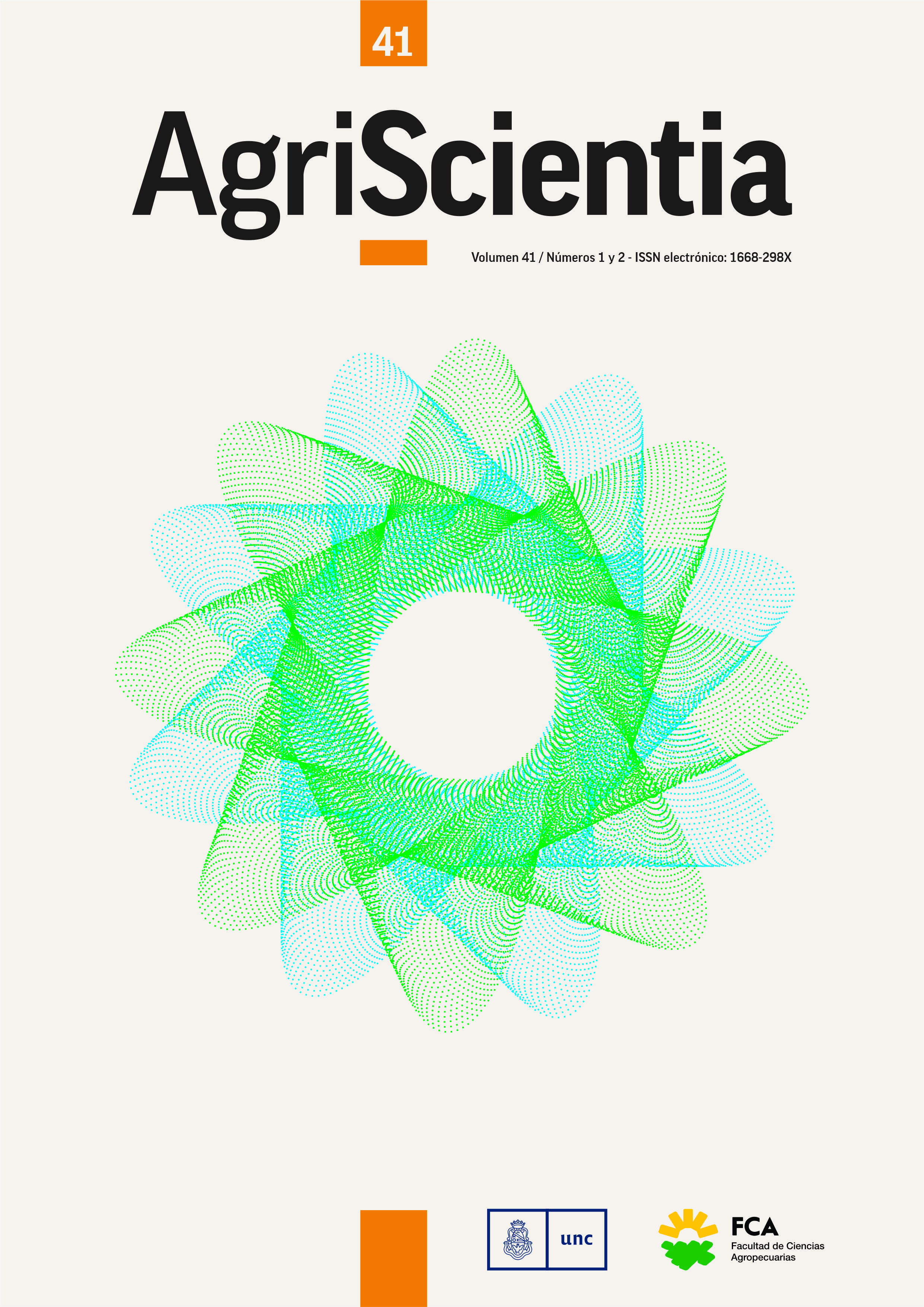Environmental impact of phytosanitary applications in intensive ornamental productions in Moreno district, Buenos Aires province
Main Article Content
Abstract
Phytosanitary management in ornamental plant production is based on the use of synthetic products causing negative effects on the environment. The aim of this work was to analyze the environmental impact (EI) of pest management in intensive ornamental production in the district of Moreno, province of Buenos
Aires. The phytosanitary management of three establishments (E1, E2 and E3) representative of the area was described. The applications were analyzed and the EI was quantified through the calculation of the Field Environmental Impact Quotient (EIQf), which considers the effect on beneficial fauna, workers and consumers. The EIQf values were variable (1172.90, 752.90 and 54.70 for E1, E2 and E3, respectively), due to differences in the doses and number of
applications. Producers used insecticides/acaricides (42 %) and fungicides/
bactericides (58 %) homogeneously. Similarity was also observed in the proportion of phytosanitary products used according to the toxicological class, applying twice as many compounds from classes III and IV than those from classes I and II. This is the first contribution on EI of phytosanitary products in ornamental productions in Argentina in general, and in the Moreno district in particular.
Downloads
Article Details

This work is licensed under a Creative Commons Attribution-ShareAlike 4.0 International License.
References
Adlercreutz, E., Huarte, R., López Camelo, A., Manzo, E., Szczesny, A. y Viglianchino, L. (2014). Producción hortícola bajo cubierta (1a ed.). Ediciones INTA.
Cornell College of Agriculture and Life Sciences (2021). EIQ Calculator. New York State Integrated Pest Management, College of Agriculture and Life Science, Cornell University. https://cals.cornell.edu/new-yorkstate-integrated-pest-management/risk-assessment/eiq/eiq-calculator
Ferro, C. (2017). Impacto ambiental de la aplicación de plaguicidas en siete modelos socio-productivos hortícolas del Cinturón Verde de Mendoza. [Tesis de Grado]. Universidad Nacional de Cuyo, Argentina. https://bdigital.uncu.edu.ar/fichas.php?idobjeto=9752
Flores, A. P., Berenstein, G., Hughes, E. A., Zalts, A. y Montserrat, J. M. (2011). Pesticide risk assessment in flower greenhouses in Argentina: the importance of manipulating concentrated products. Journal of Hazardous Materials, 189, 222–228. https://doi.org/10.1016/j.jhazmat.2011.02.028 DOI: https://doi.org/10.1016/j.jhazmat.2011.02.028
Gaona, L., Bedmar, F., Gianelli, V. y Faberi, A. (2017). Evaluación del riesgo de impacto ambiental de plaguicidas mediante el Coeficiente de Impacto Ambiental (EIQ). En Productividad y medio ambiente: ¿enfoques a integrar o misión compartida? (1a ed.). Ediciones INTA.
Defensor del Pueblo de la Provincia de Buenos Aires y la Universidad Nacional de La Plata (2015). Relevamiento de la utilización de agroquímicos en la provincia de Buenos Aires. Mapa de situación e incidencia sobre la salud. https://www.agro.unlp.edu.ar/sites/default/files/paginas/informe_agroquimicos_comprimido.pdf
Kovach, J., Petzoldt, C., Degni, J. y Tette, J. (1992). A method to measure the environmental impact of pesticides. New York’s Food and Life Sciences Bulletin, 139, 1–8. https://hdl.handle.net/1813/55750
Lillywhite, R. (2008). The environmental footprint: A method to determine the environmental impact of agricultural production. Aspects of Applied Biology, 86. https://wrap.warwick.ac.uk/1103/1/WRAP_lillywhite_0380313-200709-lillywhite_2008.pdf
Morisigue, D., Mata D A, Facciuto G. y Bullrich, L. (2012). Pasado y presente de la floricultura argentina. Ciudad Autónoma de Buenos Aires, Argentina. Ediciones INTA.
Muhammetoglu, A. y Uslu, B. (2007). Application of environmental impact quotient model to Kumluca region, Turkey to determine environmental impacts of pesticides. Water Science & Technology, 56, 139–145. https://doi.org/10.2166/wst.2007.445 DOI: https://doi.org/10.2166/wst.2007.445
Núñez, S., Maeso, D., Conde, P., Duarte, F., Núñez, P., Mieres, I. y Bruno, A. (2007). Evaluación del impacto ambiental de los plaguicidas en la producción hortifrutícola. Revista INIA, 12, 17–22. http://www.ainfo.inia.uy/digital/bitstream/item/901/1/18429270508145410.pdf
Páez, M. I., Sánchez-Andica R. A. y Castro, R. (septiembre 2013). Environmental Impact Quotient (EIQ) as an indicator for the sustainability in tomato crops with traditional and GAP´s systems. En International Conference on Pesticides Behaviour in Soils, Water and Air. York, Reino Unido.
Resolución SENASA (302/2012). Modifícase la Resolución N.º 350/99, relacionada con el manual de procedimientos, criterios y alcances para el Registro de Productos Fitosanitarios en la República Argentina. https://www.argentina.gob.ar/normativa/nacional/resoluci%C3%B3n-302-2012-198711
Sánchez, L. E. (2000). Evaluación de impacto ambiental. En F. Repetto y C. Karez (Eds.), II Curso internacional de aspectos geológicos de protección ambiental (pp. 36-68). Campinas, Brasil. http://www.ingenieroambiental.com/4012/4evaluacion.pdf
Schreinemachers, P., Sringarm, S. y Sirijinda, A. (2011). The role of synthetic pesticides in the intensification of highland agriculture in Thailand. Crop Protection, 30, 1430-1437. https://doi.org/10.1016/j.cropro.2011.07.011 DOI: https://doi.org/10.1016/j.cropro.2011.07.011
Sistema de Información Normativa y Documental Malvinas Argentinas (2020). Ley Provincia de Buenos Aires N.º 14310. https://normas.gba.gob.ar/ar-b/ley/2011/14310/11499
Tallone, V. y Cabrini, S. (2018) Evaluación de indicadores de impacto ambiental por el uso de agroquímicos y ecoeficiencia en sistemas de producción del partido de Pergamino. En XLIX Reunión Anual Asociación Argentina de Economía Agraria. Santa Fe, Argentina.
Vargas, M. (2014). Ecotoxicidad producida por agroquímicos empleados en el cultivo de Gerbera jamesonii en invernadero, en Villa Guerrero, Estado de México. [Tesis de Grado]. Universidad Autónoma del Estado de México. http://ri.uaemex.mx/bitstream/handle/20.500.11799/14895/Tesis.417957.pdf?sequence=1&isAllowed=y
Villanova, I y Morisigue, D. (2016). Relevamiento de la producción de flores y plantas ornamentales en el área Metropolitana de Buenos Aires y el Partido de San Pedro, provincia de Buenos Aires. Asociación Argentina de Floricultores y Viveristas.





